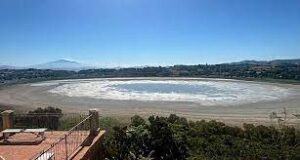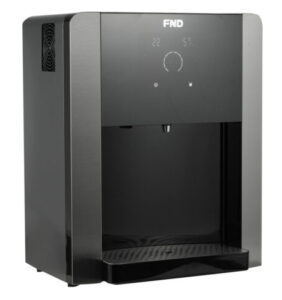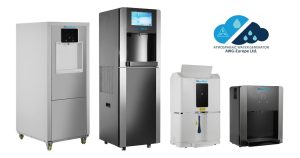The simple answer is: water costs us more and more money because there is less and less of it…
…and let’s be happy while the water is still flowing from the tap!
In this article, I would like to explore the topic of the cost of drinking water, focusing mainly on current concerns and possible solutions. Since there are thousands of pages of literature available on this topic, don’t expect a scientific treatise, but rather let’s think about—if we are affected by the problem—what efforts are being made to address it on a macro level, and what we ourselves can do on a micro level to ensure our own drinking water supply.

Many places are experiencing persistent water shortages, and the situation is expected to worsen due to climate change.
According to a report by the European Environment Agency, one-fifth of the EU’s territory and nearly one-third of its population suffer from water shortages. Even Great Britain, which is commonly thought of as a rainy country, is no exception. According to a detailed report published by the BBC a few days ago, “England could face a drinking water shortage within a decade unless new reservoirs are built.” However, the situation is much more serious in Spain, the southern EU member states, and the Mediterranean region, where water shortages are a daily problem. Just think of Sicily, Greece, or southern Spain.
And where water flows from the tap, we don’t know what we are drinking.
 The other problem is water quality, and I’m not referring to the bad taste of desalinated seawater or water transported in tankers, but to the chemical components that are harmful to health (such as PFAS persistent compounds), which are already present in at least 30% of Europe’s surface and groundwater resources and cannot be filtered out of drinking water by municipal water suppliers. We tend not to talk about this real problem, thanks to those who already control water management and related services.
The other problem is water quality, and I’m not referring to the bad taste of desalinated seawater or water transported in tankers, but to the chemical components that are harmful to health (such as PFAS persistent compounds), which are already present in at least 30% of Europe’s surface and groundwater resources and cannot be filtered out of drinking water by municipal water suppliers. We tend not to talk about this real problem, thanks to those who already control water management and related services.
In Spain, water quality is generally very good, with 99.5% of tap water considered safe according to global water standards. However, the actual quality of the water coming out of the tap can vary greatly from region to region, and even from street to street within the same city. This is due to the quality of the local water supply infrastructure and the fact that many pipes in Spain are quite old and local authorities use inorganic chloramine to keep them clean. It is worth noting that while this eliminates the presence of microorganisms, these molecules can also react with organic and inorganic dissolved compounds to form potentially toxic by-products.
Who is responsible for ensuring water supply?
Water supply in the Member States is provided by local service providers: in some places by multinational companies, in others by local authorities, and in others by state-owned water utilities. Where multinationals have entered the market, they generally provide services at significantly higher prices in order to ensure their profitability. However, the state and municipal sectors are generally underfunded, less well organized, and often leave much to be desired in terms of professionalism and resource management.
Of course, there are places where you can simply turn on the tap and drinkable water comes out, but unfortunately, more and more of our fellow EU citizens can no longer even imagine this.
The fate of huge investments
The European Union’s 2025 budget provides for a total of €199.4 billion in commitments and €155.2 billion in payments. Water supply is financed under the heading “Natural resources and environment”, for which €56.7 billion has been earmarked. This amount includes support for water management projects, sustainable water use and infrastructure development.
The quality and availability of drinking water varies from country to country in the European Union. In many places, the water network is so outdated that nearly 25% of drinking water leaks from the system, which would require an annual investment of around €23 billion to fix.
Water utility companies supply water from the source (well) to the consumer, but they have little influence on strategic water management. This is mainly up to politicians, which is a big problem, as billions of dollars usually attract lobbying interests and corruption!
Strategies and legislation are developed at the macro level
The European Union applies several laws and strategies to promote sustainable water management. The aim of EU water policy is to ensure access to good quality and sufficient quantities of water and to protect freshwater and marine ecosystems. The EU is paying increasing attention to water scarcity and the effects of climate change, and is therefore constantly developing its water management policies.
Implementation
EU Member States implement sustainable water management policies in different ways, taking into account their own geographical and economic conditions. Under the EU Water Framework Directive, all member states must develop water management plans that ensure the protection and sustainable use of water resources. Unfortunately, with a few exceptions, the use of investment resources is often ineffective, particularly in areas suffering from water shortages, and does not achieve the expected results.
What about the water supply for the population?
We ordinary people are becoming skeptical when we hear about more and more conferences where scientists and less-scientific experts who make a good living from the topic of “sustainability” make recommendations for the world in luxurious surroundings in the most beautiful places on earth. The everyday reality is that, thanks to government subsidies, we now get purified water in plastic jugs at a relatively low price, and we are satisfied with that. We have become accustomed to it, no one is dissatisfied, and no one asks whether this is sustainable in the long term and how long it will remain so cheap. A friend of mine in Dubai told me that the “cheap water for the people” program will soon come to an end there, and the price of water will reportedly increase sixfold…
How much money do we spend on drinking water?
The annual water bill for a family home generally depends on several factors, such as household size, consumption habits, and the local service provider. In general, a two-person household spends around 200-300 euros per month on water and sewage charges. This can amount to 2,400-3,600 euros per year, but for larger families or higher consumption, this amount can increase significantly.
 Those who do not drink tap water and do not have their own filter water dispenser or water generator are forced to regularly purchase the amount of mineral water or bottled drinking water they need for their daily needs, and this is true for at least 20% of European households today.
Those who do not drink tap water and do not have their own filter water dispenser or water generator are forced to regularly purchase the amount of mineral water or bottled drinking water they need for their daily needs, and this is true for at least 20% of European households today.
Currently, the price range of cheap 1.5-liter PET bottles of drinking water from 0.50 to 0.70 euros, while the price of mineral water ranges from 0.80 to 1 euro. The average drinking water requirement for a healthy adult is at least 4-5 liters per day (UN data), of which 2-3 liters are needed for drinking and cooking. Based on the cheapest PET bottled water available in the EU, this represents an expenditure of at least EUR 900-1,000 per person per year. Added to this is something that is difficult to quantify: the environmental pollution caused by logistics, storage and plastic packaging.
Solving the water problem individually

AWG-Europe Ltd. offers a new water-industrial technology: atmospheric water generators, which can be a good solution for temporary or permanent water shortages. This device utilizes moisture in the air and provides healthy, clean drinking water for family, office, community, or industrial use.
An atmospheric water generator capable of producing a maximum of 10 liters of water per day is available from €1,600. The machine requires no maintenance, only the filters need to be replaced every 6-12 months. Its power consumption is low, only 190 W/h (and only during the water production cycle). For a household-sized AWG, one liter of water will cost around 3-4 cents at the current average electricity price in Spain, and if you have a solar panel system, you can produce crystal-clear, healthy drinking water for a household of two to three people almost free of charge.
Outlook for the future
I don’t want to cause panic, but throughout history, many civilizations have disappeared into thin air due to climate change and/or drinking water shortages. In my opinion, the “advanced” Western civilization of the 21st century is also heading in this direction. It does not even acknowledge the facts it experiences firsthand, because governments and the propaganda machine ensure that it has illusions about its own future. And it will not do anything about it until it hurts enough…
WizzWell AWG machines are designed to last 10-15 years, so once you invest in one, you’ll have your water supply sorted for that long. Plus, you’ll save money in the long run. Do the math!
Are you open to innovation and want to be independent of drinking water suppliers?
…if so, choose the WizzWell atmospheric water generator that suits you best!


I must say this article is extremely well written, insightful, and packed with valuable knowledge that shows the author’s deep expertise on the subject, and I truly appreciate the time and effort that has gone into creating such high-quality content because it is not only helpful but also inspiring for readers like me who are always looking for trustworthy resources online. Keep up the good work and write more. i am a follower.
Thank you for appreciating my writings!